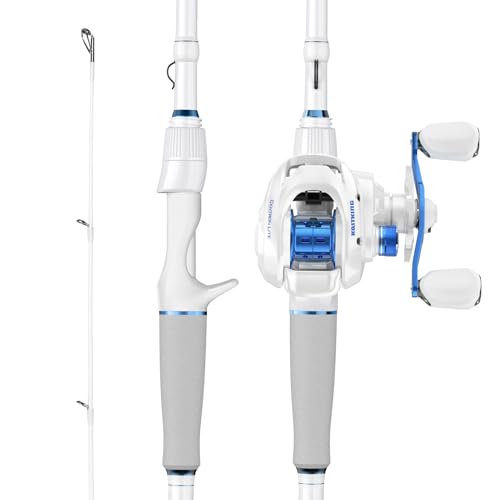A baitcasting reel is a fishing tool that allows for precise casting and control of the fishing line. It is used by anglers to cast their bait or lure with accuracy and sensitivity, making it ideal for targeting larger fish species or fishing in specific locations such as rivers or lakes.
The reel’s design enables the angler to control the speed and distance of the cast by adjusting the spool tension and thumb pressure, resulting in greater accuracy and control over the bait or lure. With its unique features, a baitcasting reel is a valuable tool for experienced anglers looking to improve their fishing technique and catch more fish.
Credit: www.goerie.com
Understanding The Basics Of Baitcasting Reels
Baitcasting reels are a popular choice among anglers for their versatility and ability to handle heavy fishing lines. Whether you’re an experienced angler or a newbie looking to dive into baitcasting, understanding the basics of these reels is crucial. In this section, we’ll explore the definition of a baitcasting reel, its components, advantages and disadvantages, and key features to consider when choosing one.
Definition Of A Baitcasting Reel
A baitcasting reel is a type of fishing reel that is mounted on top of a fishing rod. It is designed to provide more control and accuracy when casting and retrieving your lure or bait. Unlike spinning reels, baitcasting reels have a revolving spool that turns as you crank the handle, allowing for greater line control and the ability to cast heavier lures.
Key points:
- Baitcasting reels are mounted on top of the fishing rod.
- They provide better control and accuracy during casting and retrieving.
- Baitcasting reels have a revolving spool for increased line control.
Components Of A Baitcasting Reel
To understand how a baitcasting reel works, it’s important to familiarize yourself with its components. These include:
- Spool: The spool is where the fishing line is stored. It revolves as the handle is cranked, releasing or retrieving the line.
- Frame: The frame provides the structure and support for the internal components of the reel.
- Handle: The handle is used to crank the reel and retrieve the fishing line.
- Drag system: The drag system allows you to adjust the amount of resistance on the spool when a fish pulls on the line.
- Brakes: Baitcasting reels also feature adjustable brakes, which help control the speed of the spool during casting to minimize backlash.
Key points:
- Important components of a baitcasting reel include the spool, frame, handle, drag system, and brakes.
- The spool stores the fishing line, while the frame provides structural support.
- The drag system and brakes offer control over line resistance and spool speed.
Advantages And Disadvantages Of Using A Baitcasting Reel
Like any fishing gear, baitcasting reels come with their own set of advantages and disadvantages. Let’s take a look at both sides of the coin:
Advantages:
- Greater accuracy and control during casting, especially in windy conditions.
- Ability to handle heavier fishing lines and lures, making them ideal for targeting larger fish species.
- Offers more power and torque, allowing anglers to make long and precise casts.
Disadvantages:
- Steeper learning curve compared to other reel types, requiring practice to master the technique and avoid backlash.
- May be bulkier and heavier than other reel types, leading to fatigue during extended fishing sessions.
- Higher potential for backlash if not properly set up or adjusted.
Key Features To Consider When Choosing A Baitcasting Reel
When selecting a baitcasting reel, several key features should be taken into consideration:
- Gear ratio: The gear ratio determines the speed at which the spool turns. Higher gear ratios allow for faster line retrieval, while lower gear ratios offer more torque for battling larger fish.
- Ball bearings: The number and quality of ball bearings affect the smoothness of the reel’s operation. More ball bearings generally indicate smoother performance.
- Frame material: Reels can be made from different materials, such as aluminum or graphite. Aluminum frames provide durability and strength, while graphite frames offer lightweight and corrosion-resistant properties.
- Drag system: Look for a baitcasting reel with a reliable drag system that offers smooth and consistent resistance.
- Braking system: Consider the type of braking system that suits your fishing style. Some reels offer magnetic brakes, while others have centrifugal brakes.
Key points:
- Important features to consider when choosing a baitcasting reel include gear ratio, ball bearings, frame material, drag system, and braking system.
- Gear ratio determines the spool’s speed, while ball bearings affect reel smoothness.
- Frame material affects the reel’s durability and weight.
- A reliable drag system and suitable braking system are crucial for optimal performance.
Understanding the basics of baitcasting reels is essential for any angler looking to explore this reel type. Now that you have a solid foundation on what baitcasting reels are, their components, advantages and disadvantages, and key features to consider, you can make an informed decision when choosing the right baitcasting reel for your fishing needs.
Happy casting!
Mastering Baitcasting Reel Techniques
Baitcasting reels are a popular choice among anglers who want more control and precision in their fishing. These reels allow for accurate casting and a greater amount of control when reeling in fish. However, mastering the techniques of using a baitcasting reel can take some time and practice.
In this section, we will explore the proper grip and stance for using a baitcasting reel, casting techniques for different fishing scenarios, and adjusting the drag and braking system for optimal performance. We will also provide some tips for avoiding backlash and bird’s nests.
Proper Grip And Stance For Using A Baitcasting Reel
- Grip the baitcasting reel with your dominant hand, placing your thumb on the spool to control the line.
- Hold the rod with your other hand, making sure to maintain a relaxed grip.
- Stand with your feet shoulder-width apart, distributing your weight evenly for better balance.
- Position your body slightly sideways to the target, allowing for a smoother casting motion.
Casting Techniques For Different Fishing Scenarios
- Overhead cast: Start with the rod at a 45-degree angle, bring it back over your shoulder, and then forward to propel the lure towards your target.
- Roll cast: Use this technique when casting into tight spaces or when you want to make a quick and accurate cast.
- Sidearm cast: Keep the rod parallel to the ground and swing it to the side, releasing the lure towards your target.
- Pitch cast: Hold the rod at a low angle and swiftly bring it forward, allowing the lure to drop into the water with minimal disturbance.
Adjusting The Drag And Braking System For Optimal Performance
- The drag system controls the amount of resistance the fish feels when pulling on the line. Adjust it according to the size and strength of the fish you are targeting.
- The braking system helps prevent backlash by controlling the speed at which the spool spins during the cast. Adjust it based on the weight of your lure and the casting distance you desire.
- Experiment with different settings to find the right balance between casting distance and control.
Tips For Avoiding Backlash And Bird’S Nests
- Start with a slow and smooth casting motion, gradually increasing speed as you gain more control and confidence.
- Use your thumb to control the line during the cast, applying light pressure to prevent the spool from over-spinning.
- Avoid using too much force or releasing the thumb too early, as this can lead to backlash.
- Practice with different weights and types of lures to find the sweet spot that minimizes the risk of backlash.
- If a backlash does occur, take your time to untangle the line carefully, using your thumb to prevent further entanglement.
Mastering the techniques of using a baitcasting reel requires practice and patience. By following these tips and honing your skills, you can become more proficient at casting accurately and reeling in fish with ease. So, get out there, enjoy your fishing adventures, and make the most of your baitcasting reel!
Choosing The Right Baitcasting Reel For Your Fishing Needs
If you’re an avid angler, you know that having the right gear can make all the difference in your fishing experience. One essential piece of equipment that can greatly impact your success is the baitcasting reel. With so many options available in the market, it’s crucial to select the right one that suits your specific fishing needs.
In this section, we will explore the factors to consider when selecting a baitcasting reel, the different models available, expert reviews and recommendations, as well as maintenance and care tips to ensure the longevity of your reel.
Factors To Consider When Selecting A Baitcasting Reel
When it comes to choosing the right baitcasting reel, several factors should be taken into consideration. These factors include:
- Fishing environment: Determine whether you’ll be fishing predominantly in freshwater or saltwater, as this will dictate the type of reel material and construction you need for durability and resistance to corrosion.
- Targeted fish species and size: Consider the type of fish you’ll be targeting and their average size. Different species require varying reel sizes and gear ratios to accommodate their strength and movement.
- Fishing techniques and styles: Your preferred fishing techniques and styles, such as flipping, pitching, or casting long distances, will influence your reel choice. Each technique requires specific features, such as a high-speed retrieve or precise casting control.
- Budget: Set a budget that aligns with your needs and expectations. Baitcasting reels come in a wide range of prices, so it’s important to find one that offers the desired quality and features within your budget.
Exploring Different Baitcasting Reel Models And Their Specifications
Once you’ve determined your fishing requirements, it’s time to explore the various baitcasting reel models available. Here are some popular models along with their key specifications to consider:
- Shimano curado dc: Known for its smooth casting and reliable braking system, this reel offers precise control and excellent line management.
- Abu garcia revo sx: With its lightweight design and strong drag system, this reel is perfect for anglers looking for versatility and consistent performance.
- Daiwa tatula sv tw: Featuring a compact profile and advanced technology, this reel delivers unmatched casting accuracy and control.
Reviews And Recommendations From Fishing Experts
To get a better understanding of the performance and reliability of different baitcasting reels, it’s beneficial to seek reviews and recommendations from fishing experts. These experts have hands-on experience with various reels and can provide valuable insights to help you make an informed decision.
Look for expert opinions through online fishing forums, blogs, and youtube channels.
Maintenance And Care Tips To Prolong The Lifespan Of Your Baitcasting Reel
To ensure the longevity of your baitcasting reel, proper maintenance and care are essential. Here are some tips to help you keep your reel in top condition:
- Regularly clean your reel with a soft cloth and remove any built-up dirt or debris.
- Lubricate the moving parts of the reel, such as the gears and bearings, to prevent corrosion and ensure smooth operation.
- Store your reel in a dry and cool place to prevent any moisture damage.
- Avoid exposing your reel to extreme temperatures or harsh conditions that may affect its performance.
- Make sure to follow the manufacturer’s instructions for maintenance and servicing.
By considering the fishing environment, target species, fishing techniques, budget, exploring different reel models, seeking expert recommendations, and maintaining your reel properly, you can choose the right baitcasting reel that will enhance your fishing experience and help you reel in your dream catch.
Conclusion
To sum up, baitcasting reels are essential tools for any angler looking to elevate their fishing game. With their precise casting accuracy and the ability to handle heavy lines and lures, baitcasting reels offer superior control and power. From targeting larger fish species to navigating challenging fishing conditions, these reels provide the necessary performance to increase your chances of success.
Additionally, the adjustable drag system allows anglers to fine-tune the resistance, ensuring a smooth line release when battling with a fish. Remember to choose a baitcasting reel that suits your fishing style, skill level, and target species. With proper technique and practice, you can master the art of casting with a baitcasting reel, allowing you to enjoy the thrill of accurate and powerful casts.
So, whether you’re an experienced angler or a beginner, incorporating a baitcasting reel into your arsenal is a game-changer that will take your fishing experience to new heights.




